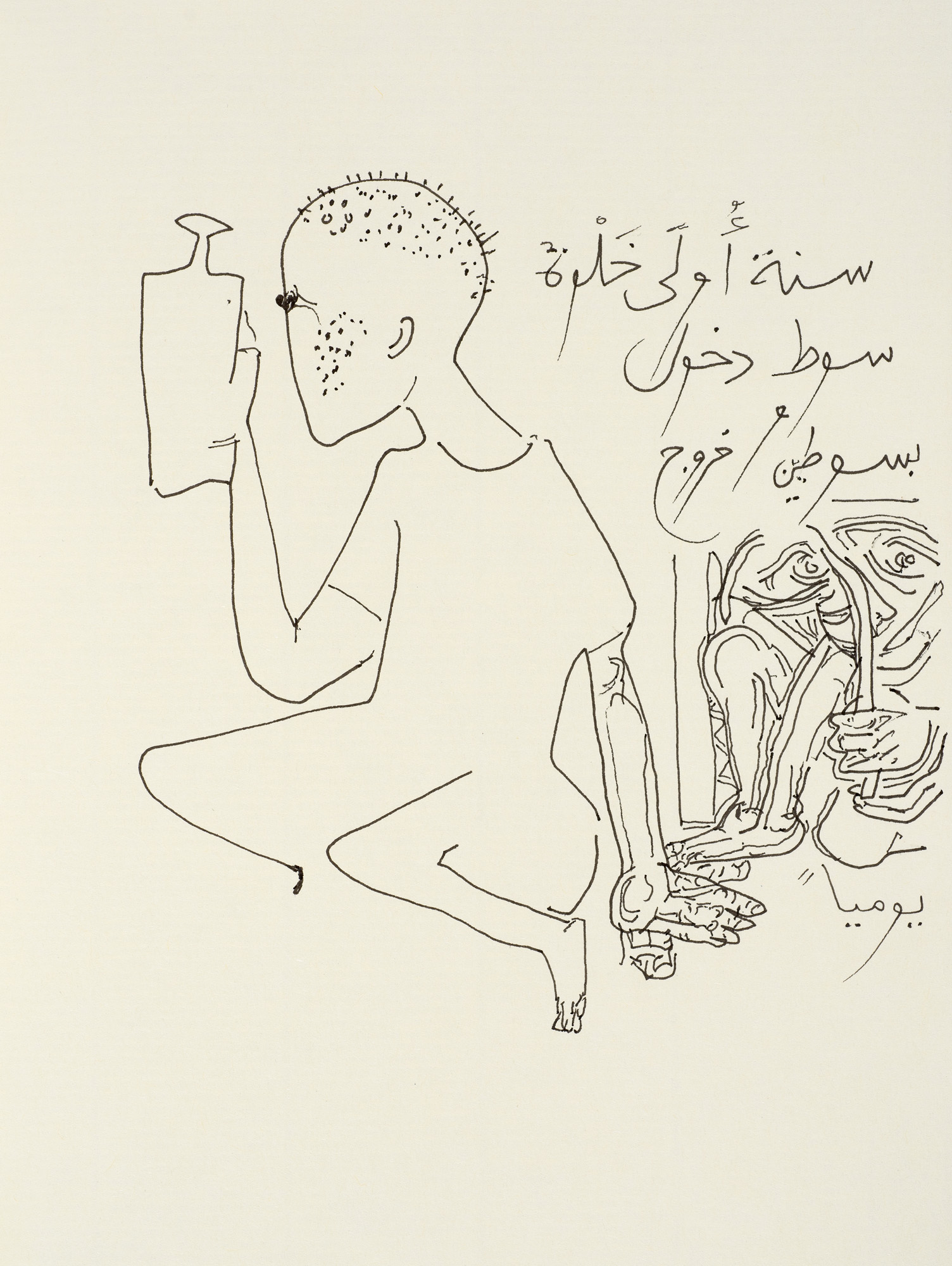Ibrahim El-Salahi's Exhibition at the S2 Gallery
The S2 Gallery presents a solo exhibition of works by Ibrahim El-Salahi, an artist regarded as one of the pioneers in modernism. El-Salahi was a pioneer in developing a new visual language that incorporated a blend of Islamic, African, Arab and Western traditions. In this exhibition are two major works – one is a recent painting, and the other is a set of 82 drawings in a series called Life Diary (2014-16).
A major component of the exhibition, Life Diary offers an-depth illustrated autobiography by the artist in the form of a visual diary. Life Diary is preceded by two other visual diaries which document key transformative moments in El-Salahi’s life.
In 1930, El-Salahi was born in El-Abbasiya, Omdurman, to a family of Islamic scholars called “Ahl El-Jami” (the people of the mosque). His father was Sheikh Mohammed El-Salahi Othman, his grandfather was Judge Osman Arabi, and his great-grandfather was Judge Arabi El-Hawwari. After studying at the khalwa (Qur’anic School), El-Salahi completed his formal education in 1948 before entering the School of Design at the Gordon Memorial College in Khartoum, and the Slade School of Fine Art afterwards.
One of his earliest visual memoirs, Prison Notebook (1976) is a visual memoir of El-Salahi’s time in Khartoum’s Kober Prison. From 1969 to 1998, El-Salahi held various government positions in African and Arab cultural policy. In September 1975, Ibrahim El-Salahi was arrested and imprisoned on false accusations of anti-government activities. He was serving as the Undersecretary in the Ministry of Culture and Information for the Sudanese government at the time. Prison Notebook documents his six month long imprisonment without trial in the most inhumane conditions. The drawings illustrate El-Salahi’s gloomy memories of the cells, his isolation with only a bird for company, and his visions of a flying horse, among others. Upon his release El-Salahi left Sudan to live in exile in Doha, Qatar and then in Oxford, England.
Ibrahim El-Salahi continued his drawings with Visual Diary of Time-Waste Place (1996-97), reflecting on his time in Qatar living in exile. While in Qatar, El-Salahi was working in the palace offices of the Qatari government, and happened to find a ‘set of square blank books’, on which he produced the fifty-seven compositions that now make up Visual Diary of Time-Waste Palace. The series depicts El-Salahi’s solitude and isolation in Qatar, adjusting to a new environment and reflecting on his home in Sudan. His musings are illustrated with endless lines and patterns with undulating abstract forms.
In 2013, the Tate Modern presented ‘Ibrahim El-Salahi: A Visionary Modernist’, a retrospective exhibition of 100 works from over El-Salahi’s 50 year career. A year later, the artist began ‘Life Diary’, taking a comprehensive overview of his life so far. In Life Diary, we see a series of thin-lined drawings depicting his journey from birth, through imprisonment and exile. As with much of his work, Life Diary includes ‘motifs and images, styles and forms drawn from an array of classical and traditional African, Arab and Islamic visual sources as well as from European ones’1. El-Salahi was part of the Khartoum School of artists who believed in using Arabic letter forms ‘as living figural elements’2. At that time, the Arabic language was deemed solely for use in sacred texts. El-Salahi included Arabic prose and poetry to describe and contextualise his drawings. In addition to the Arabic calligraphy, El-Salahi incorporated African motifs and intricate decorative patterns in the series. He also illustrated the Sudanese horizon with mosques, the sea, the crescent moon, consistent use of birds, and anthropomorphic features of cattle in drawings of himself.
As an African born into Arab and Muslim traditions, El-Salahi transcended his cultural boundaries with his contributions to the Khartoum school, which he formed with colleagues Ahmed Shibrain and Kamala Ishag. Beyond the Khartoum School, Ibrahim El-Salahi has been a long-standing modern artist who contributed imagery from a blend of African and Arab cultures. El-Salahi’s work is held in numerous museum collections including the Museum of Modern Art in New York and Tate Modern in London. He has also been awarded the Rockefeller Foundation Fellowship (1964-54); the Order of Knowledge, Arts, and Letters, Sudan (1975); and the Prince Claus Award (2001).3
The exhibition of works by Ibrahim El-Salahi is on at the S2 Gallery from 9 October – 17 November, 2017.
1 Salah H. Hassan, Ibrahim El-Salahi: A Visionary Modernist, Page 11
2 Ibid, Page 14 - 15
3 Ibid Page 188
This article was originally written for the Sotheby's Modern & Contemporary African Art Blog



